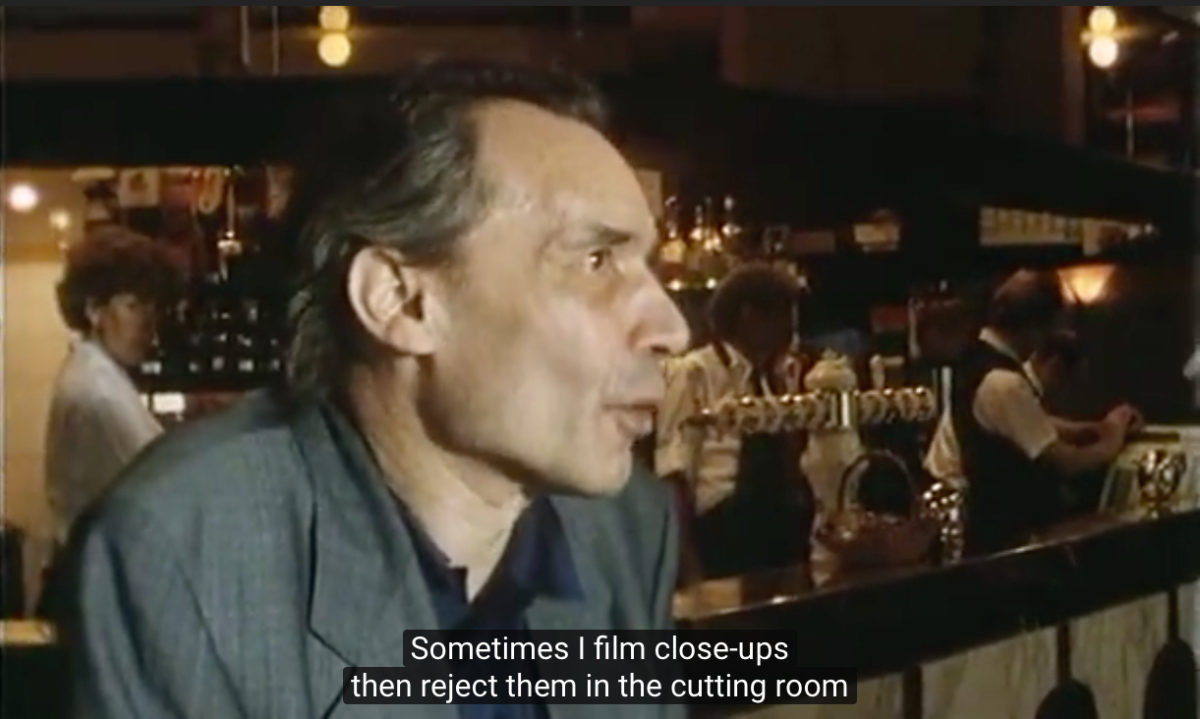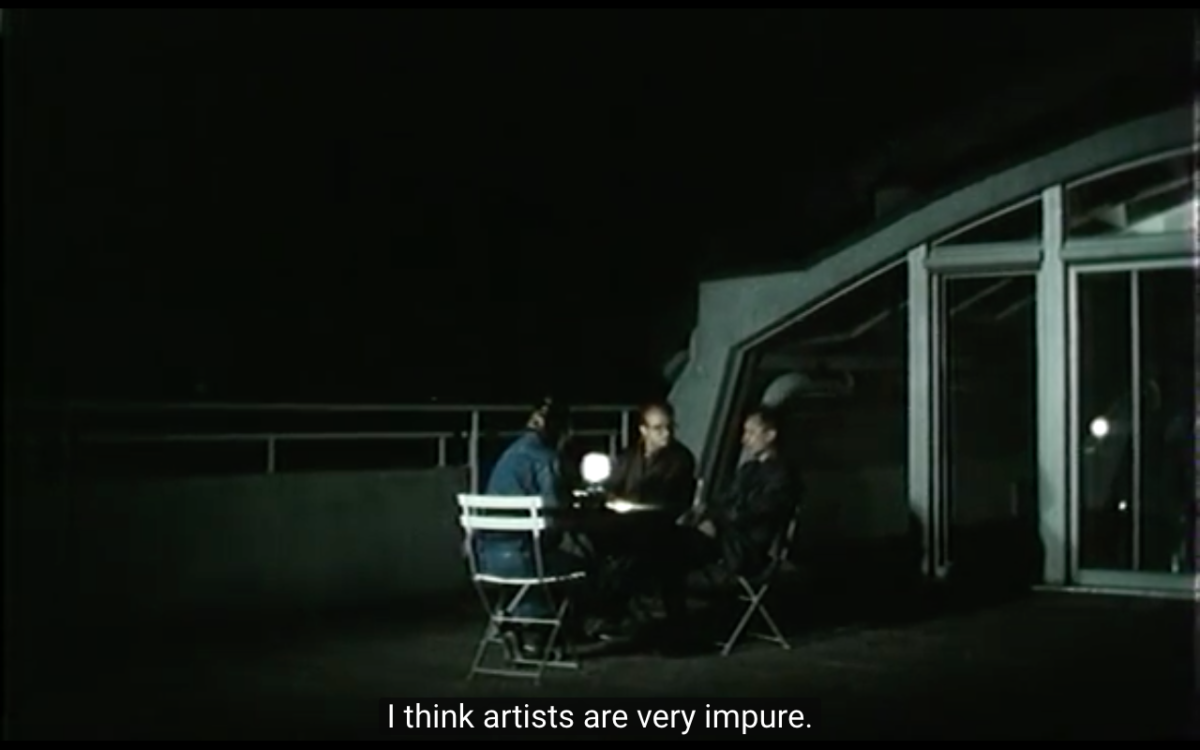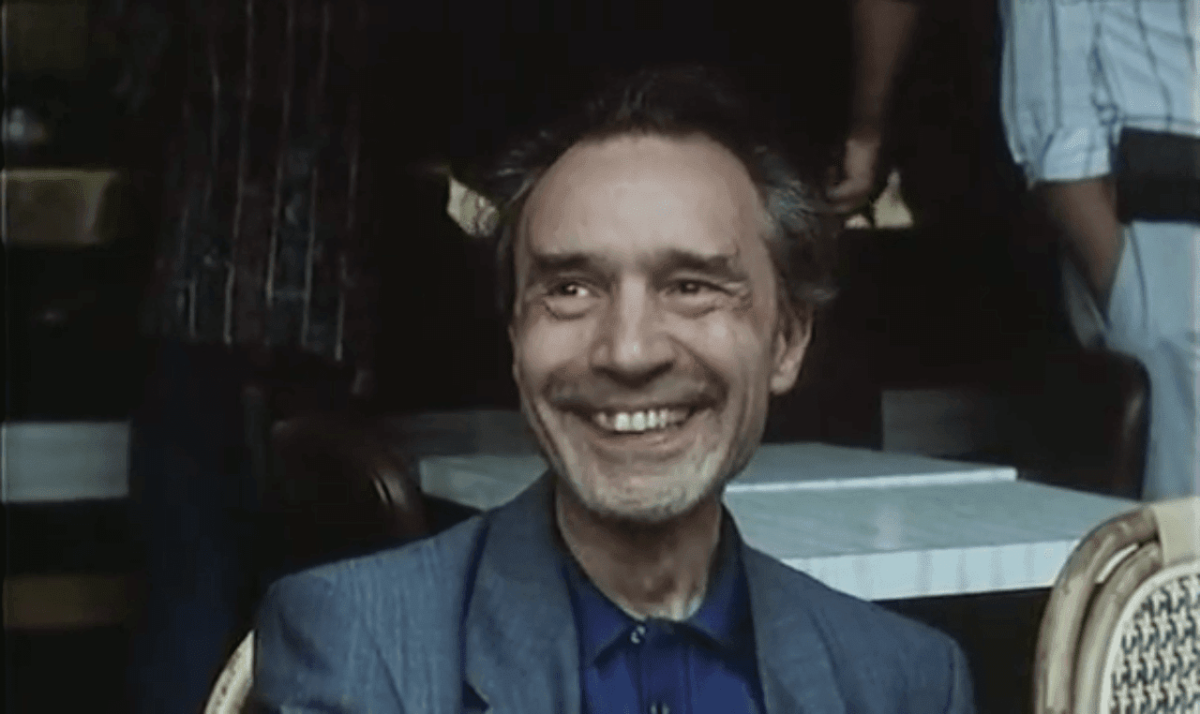Before convening under the auspices of Film Fest Gent, we participants in the Young Critics Workshop are asked to name a favored “cinephiliac moment.” Were we to be posed the same question again upon our disbanding, but having to select from what we saw during the festival, I wouldn’t be alone in thinking immediately back to the screening of Jacques Rivette, the Watchman (Jacques Rivette, le veilleur, 1990), Claire Denis’ two-part contribution to the storied French television series ‘Cinéma, de notre temps.’ Raymond Bellour was on hand to speak about his late colleague Serge Daney, who interviews Rivette in the film. Although Daney is today more associated with the left-wing newspaper Libération and the journal Trafic (which he co-founded with Bellour in 1991, less than a year before his premature death), he spent the majority of his career on the staff of Cahiers du cinéma, joining in 1964 during none other than Rivette’s two-year stint as editor-in-chief.
The onscreen presence of an interlocutor, let alone one as wisely contemplative as Daney, already signals that this homage to a director is unlike most others. Interview features might be the dominant sub-genre within the sub-genre of films about filmmakers, but they tend to be as listlessly wooden as talking-head pieces come. There’s no reason why a filmic encounter with a director shouldn’t be visually playful and dynamic. (It’s understandable that one of the other sub-sub-genres, the on-set documentary, is often limited by constraints of space, time, and energy. But a third breed, the eulogy and/or reappraisal, shows how much can be done with archival footage, interviews of friends and colleagues, and critical analysis. Access to the director in the flesh is icing on the cake that often goes to waste in the most generic interview-based portraits.) Though often relegated to the clearinghouse of DVD special features, examples of compelling essay films on filmmakers both living and dead abound.By no means a comprehensive or evaluative list, some examples of films on filmmakers beyond the corpus of ‘Cinéastes/Cinéma de notre temps’ but in a similar vein of either intimate career overview or critical reflection include Peter Bogdanovich’s Directed by John Ford (1971), Patrick Montgomery’s The Man You Loved to Hate (1979; on Erich von Stroheim), Philo Bregstein’s Whoever Tells the Truth Shall Die (1980; on Pasolini), Kevin Brownlow and David Gill’s Unknown Chaplin (1983), Edgardo Cozarinsky’s Jean Cocteau: Autobiography of an Unknown (1983), Leo De Boer and Jurriën Rood’s The Road to Bresson (1984), George Stevens Jr.’s George Stevens: A Filmmaker’s Journey (1984), Michael Ventura’s ‘I’m Almost Not Crazy’: John Cassavetes, The Man and His Work (1984), Christian Blackwood’s Signed: Lino Brocka (1987), Paul Joyce’s Motion and Emotion: The Films of Wim Wenders (1989), Manthia Diawara’s Rouch in Reverse (1995), Torben Skjødt Jensen’s Carl Th. Dreyer: My Metier (1995), Carlo Lizzani’s Luchino Visconti (1999), José Luis López-Linares and Javier Rioyo’s Regarding Buñuel (2000), Damian Pettigrew’s Fellini: I’m a Born Liar (2002), Peter von Bagh’s Edvin Laine (2006), Mario Canale’s Marco Ferrerri: The Director Who Comes from the Future (2007), Carlo Di Carlo’s Antonioni on Antonioni (2008), Felix Möller’s Harlan – In the Shadow of Jew Süss (2008), Stig Björkman’s …But Film is My Mistress (2010, on Bergman), Susan Ray’s Don’t Expect Too Much (2011; on her late husband Nick), Joey Figueroa and Zak Knutson’s Milius (2013), Noah Baumbach and Jake Paltrow’s De Palma (2015), Samba Gadjigo and Jason Silverman’s Sembene! (2015), and finally, in the new ‘Meet the Filmmakers’ series hosted on the Criterion Channel of FilmStruck (where some episodes and clips from ‘…de notre temps’ can also be found), David Thomson’s 2016 portrait of Athina Rachel Tsangari and Michael Chaiken’s 2017 doc on the Safdie brothers. Much of the crème de la crème is to be found in the history of ‘Cinéma, de notre temps,’ which has gained some overdue appreciation through a 2011 book by its co-founder, André S. Labarthe, a retrospective at the 50th New York Film Festival in 2012, and scattered digital distribution via MK2 and the Criterion Collection. If not explicitly part of its mission statement, a guiding light of the program — commissioned in 1989 by Arte to give another life to ‘Cinéastes de notre temps,’ run on ORTF by Labarthe and Janine Bazin from 1964 to 1972 — has been the principle that films about film directors merit cinematographic rigor of their own. Viewed in light of later contributions by such established auteurs as Chantal Akerman, Olivier Assayas, Pedro Costa, and Chris Marker, the early entries appear stodgy and prototypical. It may be unkind to Jacques Rozier to compare his 1964 film on Jean Vigo (the original series’ second episode) to all of those which had their subject at hand, let alone still living at all. Doing so is instructive, though, because it highlights one of this series’ foremost qualities: an ability to turn staged encounters gradually into something unmistakably organic.
Consider the plasticity of how Denis, abetted by her sidekick cinematographer Agnès Godard, shoots the myriad interview scenes. After an apt opening sequence of Rivette wandering through a gallery of Art Brut tableaux — perhaps accumulating inspiration for the film he was developing at the time, La belle noiseuse (1991), a similarly immersive, temporally circumscribed portrait of an older artist —, the film begins its first part (‘Le jour’) in earnest with Serge Daney and Jacques Rivette side by side at a counter looking out from a café onto the street. The energy passing around the camera is palpable, as is the activity behind them within the establishment. As Rivette talks about his aversion to editing, or rather his preference for capturing motion in its sanctity, the camerawoman pricks her ears up at a mention of the close-up and then moves in toward the director to pay special attention to his thoughts on this point.

After an outdoor excursus, the conversation becomes more intimate — diving into Rivette’s memories of coming from Rouen to Paris with nothing but a few contacts, then progressively meeting and befriending Truffaut (meeting him, reputedly at a Cinémathèque Française screening of their master’s The Rules of the Game, through Suzanne Schiffman), Rohmer (then still using his birth name Maurice Schérer), and Godard —, and the scene slinks perfectly into a corner of their next café.
The moments during which Rivette isn’t onscreen are seldom and speedy, but they buttress his hunkering presence amply. A first, ever so brief, interlude comes when Rivette and Daney’s conversation moves outside. Denis introduces the site of their promenade, the multiplex-lined Champs Élysées, with a cutesy shot of a blonde in a convertible swiveling her head while halted at a red light. She then pivots to the two men, strolling in a parking lane as if to call attention to the exceptional status of this walk. Of course, it would be almost impossible to shoot at such a leisurely pace moving down the busy adjacent sidewalk, but the placement of our subjects in the street itself feels doubly necessary. Rivette and his New Wave peers were among the first globally, and certainly in France, to take their cameras right onto boulevards and into moving vehicles. They own these streets, this scene almost declares, and if the master elects to have his portrait taken there, then rightfully so.
Interviews with stock players Bulle Ogier and Jean-François Stévenin throw a bit of light on their collaboration with him over the years, but mostly they shroud him in even greater mystery. It’s astounding how little they seem to know about his life off-set. Stévenin recalls seeing him eat dinner once and being taken aback that, yes, Rivette too has the basic human need for sustenance. (We also hear Stévenin chuckle, in voice-over, watching Rivette move through a park with his “Corsican walk”: “The upper body doesn’t move; it’s just the legs!”) Ogier is less given to thinking of him in mythic terms, though she honors a certain impenetrability of his spirit by mentioning that she has certain suspicions about his personal life which she’d never dare to verbalize.
The mysterious side of Rivette is drummed up a bit by the setting of part two of the film, ‘La nuit.’ Nocturnal creature that she casts him as in the title, he appears most animated here, holed up on a neon-backlit rooftop for its duration. A light-box on the table around which Rivette, Daney, and Denis are seated radiates continuously onto our subject, but the latter two drift in and out of our sight, like supporting-character specters toward the end of Rivette’s own Out 1 (1971). As the night draws to a close, though, we pull back to view the trio from a certain distance. He no longer seems to be the solitary cinephile or titular “watchman” as we’re previously encouraged to view him. Rather, his enigmatic practice as a film artist is preserved by the texts (especially the work of the French tragedian Pierre Corneille, whom he speaks poetically about here) and the collaborators to which he keeps closest. And the city. Yes, as the panoramic closing shot of the film so gracefully suggests, Paris belongs to him.

One begins to sense, in the liminal domestic space of this rooftop, that fellow Cahiers critics like Daney and filmmakers like Denis are the closest thing he has to family. (Indeed, these two could be thought of as ersatz children: Daney began writing for Cahiers while Rivette was editor and, in one of her first jobs, Denis worked as Rivette’s assistant in the mid-1970s. This was actually what made Rivette think to ask her to make the film: he had been an assistant to Renoir, the filmmaker about whom he’d made his own ‘Cinéastes…’ offering.See ‘Claire Denis interviewed by Jonathan Romney,’ The Guardian (June 28, 2000). What’s more, Denis almost made an adaptation of an as-yet-unrealized screenplay by Renoir, Adrienne.See Cédric Mal, Claire Denis: cinéaste à part, et entière… (Paris: Verneuil, 2008) 124.) The synergy coursing through the end of their conversation is electric, with Rivette casting a shadow on the ethical implications of the art life. He paraphrases Georges Bernanos’ admiration for three types of people — heroes, saints, and children —, each representing a different form of innocence, and then adds that “an artist is never innocent.” Nothing bears the signature of Denis more than the decision to wrap things up here, both at the end of a night in Paris, so indelibly evoked in her own films like Vendredi soir (2002) and Un beau soleil intérieur (2017), and on dangerous ground pertaining to the morality of artists.
The filiation at work in Jacques Rivette, the Watchman makes it a quintessential entry in a TV series that came out of the 1960s explosion in Parisian cinephilia that had very clear godfathers, perhaps the three greatest being André Bazin (whose widow, Janine, produced the series), Henri Langlois (the founder of the Cinémathèque Française who, in Rivette’s words, “opened the doors of the temple”Antoine de Baecque, Godard: Biographie (Paris: Fayard/Pluriel, 2010) 36-27.), and Jean Renoir, the subject of Rivette’s own 1967 contribution to ‘Cinéastes.’Along with fellow Cahiers-editor-in-chief-turned-filmmaker Eric Rohmer, Rivette is the only one to be both subject and maker in a ‘Cinéma, de notre temps’ episode. Interestingly, both Rohmer and Rivette were behind the camera during the earlier ‘Cinéastes…’ iteration and in front of the camera during the ‘Cinéma…’ period, adding to the series’ historical weight. Although he was not as central of a figure at Cahiers as the major New Wave filmmakers, the series’ director André S. Labarthe was close to many of them, and appeared in Godard’s Vivre sa vie as well as in Rivette’s L’Amour fou, playing a fictionalized version of himself: a director of a TV crew recording artists at work. The 16mm footage he and his team actually shot on that set was used in the final film. The extent to which Renoir influenced the Cahiers filmmakers is too significant to outline here, although one point needs to be mentioned: just two years before ‘Cinéastes’ premiered, he’d made his own foray into portraiture of an artist with Renoir, My Father (Pierre-Auguste Renoir, mon père, 1962), a biography of the impressionist painter. We could thus see Renoir as the quite literal pipeline between Impressionism and the Nouvelle Vague, a connection that is sometimes made (if complicated by the fact that a group of French filmmakers referred to as the Première Vague have also been labelled Impressionists) because of how both movements took advantage of new technologies (tubes of paint and the combination of lightweight recording equipment and more light-sensitive film stock, respectively) and innovatively moved their work from the confines of a studio to the outdoors. Beyond their homonymous titles, a curious similarity between that book and the ‘Cinéastes’ episodes under discussion here is that the authors place strict limitations on their own appearances in the finished work, even if their kinship with the subjects is crystal-clear. Indeed, within a few minutes of Rivette’s Jean Renoir, the Boss (Jean Renoir, le patron, 1967), its director already has Renoir talking just like a member of the Nouvelle Vague. “We were obsessed with American films,” he says, “probably too much. It was cultish. Chaplin, Griffith, Stroheim, Fred Niblo, Clarence Brown.” The stodgy, slow-moving French cinema, then, was as much something to react against for him in the 20s as it would be for Truffaut et al. in the 50s. “We didn’t want to make art,” he emphasizes, differentiating his cinema from the performatively artistic one that preceded him in France. “We wanted to make cinema that was novel in spirit and that grabbed the public’s attention.”
Another great pleasure of Jean Renoir, the Boss is hearing the senior director initialed J.R. expound upon techniques that the younger J.R. will use too, such as long takes with camera movements at the service of the actors, affirming a belief in the director’s responsibility to maintain the integrity of actions and their convergence with words and gestures. Who else could be called on to edit a film by and about directors that are allergic to montage than Jean EustacheAlthough best known for his two theatrical features, Eustache would go on to direct documentaries too, including the interview-based Numéro Zero (1971), in which every take consists of a full unedited film reel.? His willingness, as a New Wave disciple, to resist the scalpel and embrace the flow of life and conversation that Rivette’s occasionally messy long takes contain is particularly showcased in part two of Jean Renoir, the Boss, ‘La Direction d’acteur.’
At several points therein, the camera circles around Renoir and Michel Simon, seated side by side, to reveal a fresh-faced Rivette poking out between the two titans. In an enraptured state, the Young Turk listens but also grins like a kid in a candy shop. His love for these mugs is palpable as he beams, for instance, at a story about Simon’s performance in Tire au flanc (1928) or a derisive remark about how the filmmakers de qualité (as Truffaut and others would lambast the generation in between themselves and Renoir) allowed rules from the theater world about lighting and blocking to dictate their mise-en-scène. This infective affection for the subjects marks the episode’s style decisively. Acting as if every second in their presence is hallowed, shots that contain an anecdote shared between the duo will trail off, refusing to cut even if their camaraderie devolves into giggling or the camera operator momentarily loses focus. If this amounts to hagiography, then at least there’s a fine aesthetic rationale behind it: meandering long takes controlled by no one other than the actors are patently a signature of Renoir’s cinema. The tone of the film is a perfect marriage of comedy and tragedy — precisely the attribute of Renoir’s oeuvre that Rivette the Cahiers critic had most celebrated.
If there is one central rivet, let’s say, connecting Renoir through Rivette to DenisAmy Taubin rightfully likened Denis’ newest film to Renoir’s The Rules of the Game (La Règle du jeu, 1939) on the count that they’re both comedies of manners made in dire historical moments., it might be something like a tragicomic view of the utter flimsiness and performativity of the bourgeoisie. Precarious lives of leisure certainly loom large in this triumvirate’s collective work, often explored most searingly in both explicit and allusive connection to theater. They each have their own affinities with the stage, but share with the medium a very fundamental concern with the body, in all of its complexity. The three directors tend to manifest this fascination quite disparately, from the amphibian grace of Michel Simon in Boudu Saved from Drowning (Boudu sauvé des eaux, 1932) or Sylvia Bataille in A Day in the Country (Partie de campagne, 1936) to the free-spirited flailing of the theater troupes in Rivette’s L’amour fou (1969) and Out 1 to the terse, disturbing sexuality in Denis’ Trouble Every Day (2001) or Bastards (Les Salauds, 2013). In these films about each other, however, their approaches are manifestly aligned. To draw their former masters in camera-ink, Rivette and Denis accumulate sketches of their faces. Not by spying on them at work, or re-hashing archival footage, but furnishing them with plein air scenes from daily life.
